Hiking the Appalachian Trail
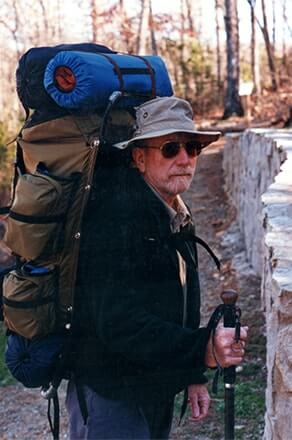
Have you ever gone on a long hike and felt good about your accomplishment? Five miles? Ten miles? Maybe 15 miles? In 1997, at the age of 59, Advent Christian Village (ACV) member Charles Moore hiked the entire Appalachian Trail — 2,160 miles from Georgia to Maine — and we can all feel good about his accomplishment.
Ever since backpacking in the mountains of North Carolina as a kid, Charles dreamed of one day hiking the entire Appalachian Trail. The trail was completed in 1937 — the year Charles was born.
After school, Charles went to work for the state of North Carolina. He worked 23 years for the Department of Transportation (DOT) and 13 years for the Division of Environment Management. While with DOT, he was drafted. He spent two years in the US military and then returned to his job with the State.
In 1993, four years prior to his trek, Charles retired because his vision was deteriorating. Doctors discovered he had a detached retina. After numerous operations, his sight was restored, and he tentatively began planning his Appalachian Trail trip in 1995
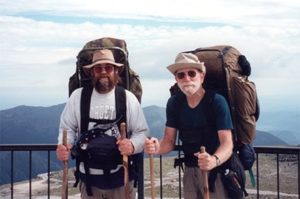 “I read articles about the Trail, but I really didn’t tell anyone I was going until a couple months before I left,” Charles said.
“I read articles about the Trail, but I really didn’t tell anyone I was going until a couple months before I left,” Charles said.
Besides reading, he made other preparations, such as visiting both ends of the Trail in advance — Georgia’s Springer Mountain and Mount Katahdin, the highest point in Maine. He also began going to the gym three times a week and hiking around his neighborhood at four in the morning. Closer to time to leave, he added 50 pounds of sand in his pack to get comfortable with the weight.
Despite the training, Charles wasn’t fully prepared for the journey. “You’ve really just got to get on the trail and do it,” he said.
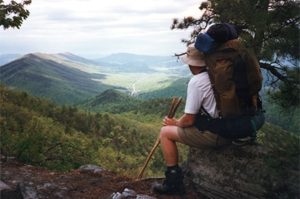 “Doing it” for Moore meant a number of what most would consider harrowing circumstances: hiking through five days of snow in Georgia, the 100-mile wilderness in Maine, 15 miles without any water in Pennsylvania, close-encounters with one skunk (which he slapped, but didn’t get sprayed by) and two rattlesnakes, and coming half a body’s length from sliding over a 40-foot cliff when his feet slipped out from under him.
“Doing it” for Moore meant a number of what most would consider harrowing circumstances: hiking through five days of snow in Georgia, the 100-mile wilderness in Maine, 15 miles without any water in Pennsylvania, close-encounters with one skunk (which he slapped, but didn’t get sprayed by) and two rattlesnakes, and coming half a body’s length from sliding over a 40-foot cliff when his feet slipped out from under him.
“The Lord helped me,” says Charles. He reckons he wore out one or two guardian angels along the way.
Armed with his two walking sticks (which he still has), his 50-pound pack full of essentials, and his trail name — Redtop — Charles set off from Springer Mountain on March 16, 1997. He and the trail turned 60 years old that year.
Fifteen days later, Charles camped in the center of the Nantahala National Forest in western NC. He spent a lot of April hiking along the NC/Tennessee border, and on April 30, camped over the border in Virginia. All of May and the first third of June, Charles hiked through Virginia. By July 1, he had hiked through Maryland and Pennsylvania and started along the Pennsylvania/NJ border.
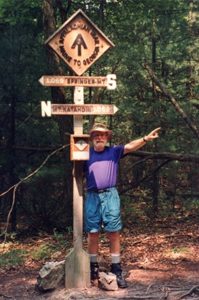 Up, up, up he went: New York, Connecticut, Massachusetts, and half of the Vermont path in July. He finished Vermont, and hiked through New Hampshire and most of the Maine leg in August. He started September west of Monson and finished his journey on Sept. 10, six days short of six months. His only break was May 27–June 2 when he travelled home to be with his wife, Jenelle, who underwent surgery.
Up, up, up he went: New York, Connecticut, Massachusetts, and half of the Vermont path in July. He finished Vermont, and hiked through New Hampshire and most of the Maine leg in August. He started September west of Monson and finished his journey on Sept. 10, six days short of six months. His only break was May 27–June 2 when he travelled home to be with his wife, Jenelle, who underwent surgery.
During his adventure, Charles called home every five to 10 days. Jenelle provided moral support and also sent Charles care packages with seasonal clothes. For a week in June, Jenelle camped with Charles, Mike “Fox-on-the-Run” Mullins (a hiker from WV Charles met in the Shenandoah Valley) and Fox’s wife, Helen, around Harper’s Ferry, northwest of Washington, DC. Charles and Fox hiked three-quarters of the Trail together.
During the week in June, the women would pick up their men in the evening, drive to a campsite, and then return them to the Trail in the morning. Charles says they were able to average 20 miles per day that week, as opposed to his average 15 miles, because they could “slack pack” those days. Slack packing is hiking with a very light pack because many necessities can be left at the campsite.
Jenelle also flew to Maine to greet Charles at the end of his journey. Prior to the trek, Charles estimated that he could finish in six months. When he had a good idea of when he would arrive at the end, he asked Jenelle to meet him in Maine on Sept. 10. He scaled a very foggy Mount Katahdin that day, and when he finished hiking down the other side, Jenelle greeted her husband with a modest celebration, complete with “I love you” shorts, balloons and medals for the three finishing hikers: Charles, Fox and Linda “Peddler” Bell, a female hiker who joined them for the last 300 miles.
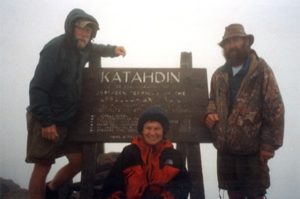 Charles is glad he completed the Trail, despite the difficulties he suffered. He and some fellow hikers decided the trek is worse than boot camp. The reason: You can’t quit boot camp, so you’re forced to stick it out. At any point on the Trail, however, you can call it quits, so you have to choose to go through the struggle. That makes it not only a physical challenge, but a mental one as well. In fact, Charles says he estimates it to be about 75% mental.
Charles is glad he completed the Trail, despite the difficulties he suffered. He and some fellow hikers decided the trek is worse than boot camp. The reason: You can’t quit boot camp, so you’re forced to stick it out. At any point on the Trail, however, you can call it quits, so you have to choose to go through the struggle. That makes it not only a physical challenge, but a mental one as well. In fact, Charles says he estimates it to be about 75% mental.
“Most people could do it,” he says, “but you have to get your mind right.” He also suggests, “Go younger. You don’t hurt as bad.” Though, he admits that the trail is more difficult now because very little of it uses roadways, which were some of the easier parts to hike in ’97.
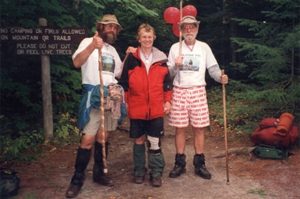 The mental toughness Charles developed during his six months on the Trail also contributed to his ability to brave the struggle he went through with complications following prostate cancer surgery in March of 2000. He says he doesn’t know if he could have gotten through that experience if he hadn’t hiked the Trail. “It helped me pull through that,” he admits.
The mental toughness Charles developed during his six months on the Trail also contributed to his ability to brave the struggle he went through with complications following prostate cancer surgery in March of 2000. He says he doesn’t know if he could have gotten through that experience if he hadn’t hiked the Trail. “It helped me pull through that,” he admits.
Through it all — a painful hammer toe, an old ankle injury that bothered him the first 500 miles, developing neuropathy in his feet, dangerous paths, bad weather and feisty varmints — Charles had the strength to press on and to persevere. He’s an inspiration.



